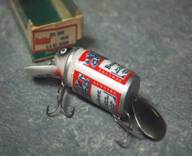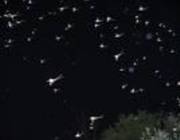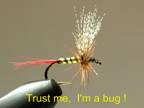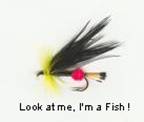WHAT FLY SHOULD I USE TODAY?
It’s a decision we make every time we approach the water. You’ve done it hundreds of times, yet we still struggle with the decision. My first instinct is to match what’s flying around, be it a major hatch, or just some local everyday caddis. No insects seen, no trout rising, my second choice would be an attractor. This is the mental conditioning I received from years of reading trout books and magazines. Your methods of fly selection are probably different then mine, and the method by which you were conditioned may be different then mine. But we all still go through the mental process. How often has your first selection of a pattern been so right that you fished with that pattern all day? A quick browse through my fishing log reveals to me that I switched patterns as many as nine times in one day.
Let’s take a look at the trout, its behavior, its instincts, the weather and a few other factors that affect the decisions a trout makes in selecting its food. My opinions have been shaped by my 50+ years of fishing experience and my background as a biology teacher. None the less they are opinions. Each trout fisherman eventually reaches a trout philosophy based on what he or she has observed. Compare your observations with mine and let’s explore the feeding habits of ‘Salmonidae’.
Let’s start with the dumb trout, that’s right, the dumb trout! Despite what you read about this so called, intelligent animal, it’s not really smart. Its brain functions on instinct. They have a keen sense of smell and sight, but that’s were it ends. Trout have the skills necessary to survive in their environment based on genetic programming, nothing more or nothing less.
 Let’s revert for a moment to bass fishing. I have in my tackle box a Budweiser Beer Can Plug and a Jimmy Carter Peanut Plug (come on guys, we all have a couple of these). The sad part of the story is that I have caught fish with both. My Jimmy Carter plug has more strike marks then some of my Rapalas. My point? Stomach contents of dissected trout have revealed leaf fragments, stones, twigs, bottle caps, etc. It would appear that the trout is not much smarter than the bass. What fly should I use today?
Let’s revert for a moment to bass fishing. I have in my tackle box a Budweiser Beer Can Plug and a Jimmy Carter Peanut Plug (come on guys, we all have a couple of these). The sad part of the story is that I have caught fish with both. My Jimmy Carter plug has more strike marks then some of my Rapalas. My point? Stomach contents of dissected trout have revealed leaf fragments, stones, twigs, bottle caps, etc. It would appear that the trout is not much smarter than the bass. What fly should I use today?
Ever try to select a fly to use when the barometer is falling. Overcast above, major storm approaching? Good luck! Sure, we’ve all had an occasional trout on the line but the vast majority of the time you’re just pounding dead waters. The falling barometer has put the trout down and there is nothing you can do about it. What fly should I use today?
How about those dog days of summer, when water levels are low and water temperatures are rising. Trout must burn a lot of energy chasing things around the river on hot days. Much better if they hide in the cool shade or in the cool deep pools, and wait for better times to feed, like night, when they don’t have to burn up so much energy. The only food they will probably take under those circumstances is food placed directly over them, so they don’t have to work hard. What fly should I use today?
What about spookiness, phases of the moon, poorly presented flies, bait fisherman, canoes and tubers, overhead birds of prey and all the other distractions in a trout’s day? What fly should I use today?
Where am I going with this? I’m trying to say that there are times when you just aren’t going to catch any fish. So try as we do, our time might be better be spent in more productive pursuits, such as time at the local fly shop, or drinking a Manhattan at the nearest fishing lodge. What fly should I use today?
What about the positive times? The times when the trout are on the feed bag, and when opportunity knocks we must now decide which fly to select from the dozens of pattern we have with us. A decision is called for, and you’re hesitating. What fly should I use today?
 Let’s start with the ‘matching the hatch’ concept. We’re all familiar with it. Any trout fisherman who’s been on the water during a major hatch has observed the phenomena. The insects fall in significant quantities and the trout rise in significant quantities. Think like a trout --- little yellow insects are falling all around me --- I rise to eat the little yellow insects. I don’t have to chase them all around the river. I just sit here and they come to me. My belly is full and I had to do no work. Now, while I’m eating these little yellow bugs, a large green thing lands several feet away from me. Why would I move to feed on it when all I have to do is sit here and eat these little yellow bugs? Yes, when there is a major hatch on, the ‘match the hatch’ concept really works, as long as you put the fly right over the fish. The aftermath of a major hatch is that their bellies are now full and they won’t be feeding for a while. So the next morning, or so, they aren’t hungry and won’t be for a while. You can toss all the little yellow things you want and they won’t go near them. What fly should I use today?
Let’s start with the ‘matching the hatch’ concept. We’re all familiar with it. Any trout fisherman who’s been on the water during a major hatch has observed the phenomena. The insects fall in significant quantities and the trout rise in significant quantities. Think like a trout --- little yellow insects are falling all around me --- I rise to eat the little yellow insects. I don’t have to chase them all around the river. I just sit here and they come to me. My belly is full and I had to do no work. Now, while I’m eating these little yellow bugs, a large green thing lands several feet away from me. Why would I move to feed on it when all I have to do is sit here and eat these little yellow bugs? Yes, when there is a major hatch on, the ‘match the hatch’ concept really works, as long as you put the fly right over the fish. The aftermath of a major hatch is that their bellies are now full and they won’t be feeding for a while. So the next morning, or so, they aren’t hungry and won’t be for a while. You can toss all the little yellow things you want and they won’t go near them. What fly should I use today?
The presence of day-to-day insect life, ants, bees, hoppers, beetles, etc. can and should be a guide in you selection of flies. The whole secret here lies in your powers of observation. Small, localized hatches of caddis, stoneflies and midges are most always present. Having the knowledge of what’s going on in your area is of the most importance. The local fly shops can be a big help with this information. They will help you choose --- what fly should I use today?
We must also remember that the trout is a wild animal whose biological need for food triggers an aggressive posture. When the feeding mechanism has been stimulated the trout will feed. Being present at this time with waders and rod is a definite plus in your favor. If we only knew for sure what factors triggered the feeding stimulus, and could be present at all such occasions there would be no more trout.
 It is this aggressive feeding behavior that the trout fisherman is looking for. During these times the trout is more then likely to attack with reckless abandonment. Have you ever had the experience of making a cast, only to watch a trout move toward your fly before it has even hit the water? Possibly even going airborne for the fly. If you haven’t had the experience yet, just keep fishing, you’ll experience it soon enough. Now, let’s explore this for a moment. We know that trout have excellent eyesight. However, the fly is moving through the air, the current is moving, the fish is moving. Are you telling me that the trout has identified the object as a natural insect? Even though it is tied with green peacock herl and red floss with white wings and black thread. I don’t think so. But just to be on the safe side I sure am glad I used black thread instead of brown thread. The trout may have spotted the brown thread and changed its mind. What fly should I use today?
It is this aggressive feeding behavior that the trout fisherman is looking for. During these times the trout is more then likely to attack with reckless abandonment. Have you ever had the experience of making a cast, only to watch a trout move toward your fly before it has even hit the water? Possibly even going airborne for the fly. If you haven’t had the experience yet, just keep fishing, you’ll experience it soon enough. Now, let’s explore this for a moment. We know that trout have excellent eyesight. However, the fly is moving through the air, the current is moving, the fish is moving. Are you telling me that the trout has identified the object as a natural insect? Even though it is tied with green peacock herl and red floss with white wings and black thread. I don’t think so. But just to be on the safe side I sure am glad I used black thread instead of brown thread. The trout may have spotted the brown thread and changed its mind. What fly should I use today?
 This aggressive feeding behavior probably accounts for the many strange objects recovered in the stomachs of trout. Ignoring for the moment, the twigs and leaves and such, look at the stuff that we throw at them. Red, green, orange, glittery, hairy, plastic, and foam to mention just a few. I doubt for a moment that the trout even thinks it looks like an insect or fish. But a foreign object has invaded its space and the trout being an aggressive predator on the feed must challenge it. What fly should I use today?
This aggressive feeding behavior probably accounts for the many strange objects recovered in the stomachs of trout. Ignoring for the moment, the twigs and leaves and such, look at the stuff that we throw at them. Red, green, orange, glittery, hairy, plastic, and foam to mention just a few. I doubt for a moment that the trout even thinks it looks like an insect or fish. But a foreign object has invaded its space and the trout being an aggressive predator on the feed must challenge it. What fly should I use today?
We all are seekers of the “perfect conditions syndrome”. Let’s see; I’m looking for a river with water temperatures in the 50’s. We want high oxygen content, a modest current with lots of structure, either a heavy cloud cover or a natural canopy, and a stream that is wide enough to cast across, but shallow enough to wade. A high trout count per mile. A pleasant mixture of holes ripples, feeding lanes, runs and pocket waters. We want a steady barometer and a nice mixture of gravel, cobblestones and boulders. The ultimate condition being that the waters would hold at least three species of trout. When you find this, please give me a call and I’ll answer the question for --- what fly should I use today?
See you on the water…..
Tom Deschaine
Copyright 2009©Deschaine
